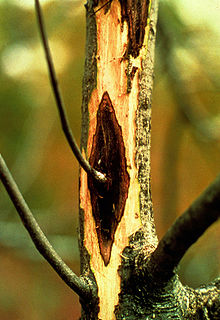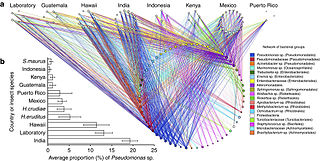Pseudomonas putida is a Gram-negative, rod-shaped, saprotrophic soil bacterium.

A plant canker is a small area of dead tissue, which grows slowly, often over years. Some cankers are of only minor consequence, but others are ultimately lethal and therefore can have major economic implications for agriculture and horticulture. Their causes include a wide range of organisms as fungi, bacteria, mycoplasmas and viruses. The majority of canker-causing organisms are bound to a unique host species or genus, but a few will attack other plants. Weather and animals can spread canker, thereby endangering areas that have only slight amount of canker.
"Pseudomonas blatchfordae" is a Gram-negative soil bacteria isolated from tomato pith necrosis and the common bean. It is not a validly recognized species. Based on 16S rRNA analysis, it falls within the P. fluorescens group.

Pseudomonas fulva is a Gram-negative environmental bacterium, originally isolated from rice and commonly associated with rice plants, grains and paddy fields. It is rod-shaped and motile using one to three polar flagella.
Pseudomonas vranovensis is a Gram-negative soil bacterium.
Pseudomonas thermotolerans is a Gram-negative, aerobic, rod-shaped bacterium found in the industrial cooking water of a cork-processing plant. It is capable of surviving at 47 °C (117 °F), hence its name. The type strain is DSM 14292.
Pseudomonas palleroniana is a Gram-negative bacterium that infects rice. The type strain is CFBP 4389.
Pseudomonas trivialis is a fluorescent, Gram-negative bacterium isolated from the phyllosphere of grasses. The type strain is DSM 14937.
Pseudomonas poae is a fluorescent, Gram-negative bacterium isolated from the phyllosphere of grasses. The type strain is DSM 14936.
Pseudomonas congelans is a fluorescent, Gram-negative bacterium isolated from the phyllosphere of grasses. The type strain is DSM 14939.
Pseudomonas amygdali is a Gram-negative plant pathogenic bacterium. It is named after its ability to cause disease on almond trees. Different analyses, including 16S rRNA analysis, DNA-DNA hybridization, and MLST clearly placed P. amygdali in the P. syringae group together with the species Pseudomonas ficuserectae and Pseudomonas meliae, and 27 pathovars of Pseudomonas syringae/Pseudomonas savastanoi, constituting a single, well-defined phylogenetic group which should be considered as a single species. This phylogenetic group has not been formally named because of the lack of reliable means to differentiate it phenotipically from closely related species, and it is currently known as either genomospecies 2 or phylogroup 3. When it is formally named, the correct name for this new species should be Pseudomonas amygdali, which takes precedence over all the other names of taxa from this group, including Pseudomonas savastanoi, which is and inadequate and confusing name whose use is not recommended.
Pseudomonas jinjuensis is a Gram-negative, non-spore-forming, motile, single polar flagellated, yellow-white, rod bacterium isolated from soil in the Jinju Region of Korea. The type strain is LMG 21317.
Pseudomonas koreensis is a Gram-negative, non-spore-forming, motile, multiple polar flagellated, yellow-white, rod bacterium isolated from farming soil in Korea. The type strain is LMG 21318.
Pseudomonas umsongensis is a Gram-negative, non-spore-forming, motile, single polar-flagellated, yellow-white, rod-shaped bacterium isolated from the soil in the Umsong region of Korea. The type strain is LMG 21317.
Pseudomonas meridiana is a psychrophilic, Gram-negative, motile with a polar flagellum, rod-shaped bacterium isolated from cyanobacterial mats in Antarctica.
Pseudomonas proteolytica is a psychrophilic, Gram-negative, motile with a polar flagellum, rod-shaped bacterium isolated from cyanobacterial mats in Antarctica.
Pseudomonas parafulva is a Gram-negative bacteria. It is epiphytic and has been demonstrated to antagonise the fungal plant pathogen Botrytis cinerea.
Pseudomonas coronafaciens is a Gram-negative bacterium that is pathogenic to several plant species. Following ribotypical analysis several pathovars of Pseudomonas syringae were incorporated into this species.

"Pseudomonas tomato" is a Gram-negative plant pathogenic bacterium that infects a variety of plants. It was once considered a pathovar of Pseudomonas syringae, but following DNA-relatedness studies, it was recognized as a separate species and several other former P. syringae pathovars were incorporated into it. Since no official name has yet been given, it is referred to by the epithet 'Pseudomonas tomato' .
"Pseudomonas helianthi" is a Gram-negative plant pathogenic bacterium that infects a variety of plants. It was once considered a pathovar of Pseudomonas syringae, but following DNA-relatedness studies, it was recognized as a separate species and P. syringae pv. tagetis was incorporated into it, as well. Since no official name has yet been given, it is referred to by the epithet 'Pseudomonas helianthi' .


